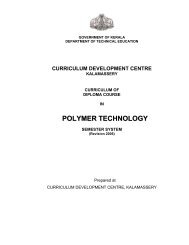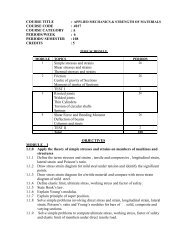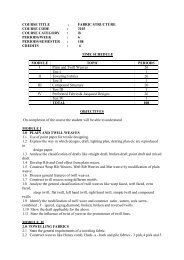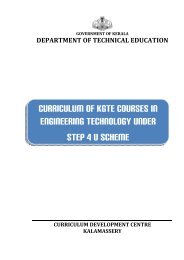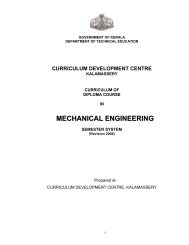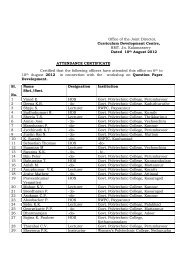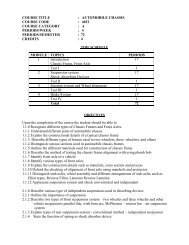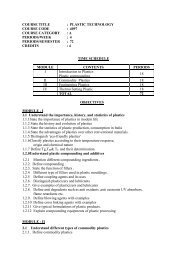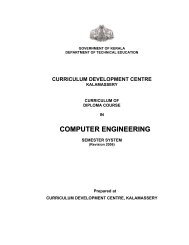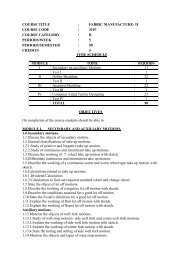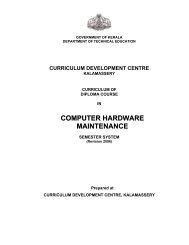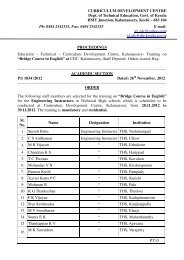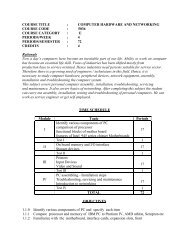13 - Curriculum Development Centre, Kalamassery
13 - Curriculum Development Centre, Kalamassery
13 - Curriculum Development Centre, Kalamassery
- No tags were found...
Create successful ePaper yourself
Turn your PDF publications into a flip-book with our unique Google optimized e-Paper software.
2.1.3. Calculate voltage regulation and efficiency from predetermined data obtained from O.C and S.Ctests2.1.4. Obtain the equivalent circuit parameters from O.C and S.C test data and draw the equivalentcircuit2.1.5. Describe the procedure of direct load test on 1 phase transformer, determine efficiency andregulation2.1.6. Understand the applications of three-phase transformer and method of connections2.1.7. Sketch and explain open delta connection2.1.8. Distinguish between the power transformer and distribution transformer2.1.9. Understand the need of tertiary winding2.1.10. Define the term All day efficiency and compute All day efficiency from given data with referenceto distribution transformerUNIT - III3.1.0. Understand the Principle and Application of Special Purpose Transformers3.1.1. Draw the constructional details of auto transformers3.1.2. Differentiating between 2 winding and single wining transformers based on power transferred byinduction and conduction3.1.3. Compute the amount of copper saving in an auto transformer an compared to a 2 windingtransformer of the save capacity and voltage ratio3.1.4. State the applications of auto transformer3.1.5. Identify the advantages and disadvantages of auto transformer over 2 winding transformer3.1.6. State the need for voltage control by tap changing systems3.1.7. Identify the principle and methods of tap changing3.1.8. State the applications of OFF load and ON load tap changing based on principle of operations3.1.9. Relate the temperature raise and losses in a transformer3.1.10. List out the various methods of cooling transformers as per ISI standard3.1.11. Draw the details of different types of cooling system3.1.12. Understand the principle of current transformer3.1.<strong>13</strong>. State the specifications of C.T, class of accuracy of C.T3.1.14. State the practical applications of C.T3.1.15. Precautions for C.T connections3.1.16. Principle of P.T.3.1.17. Specifications and applications of P.TUNIT - IV4.1.0. Understand the Principle of Induction Motors4.1.1. Know the parts of an induction motor and the materials used for each part.4.1.2. Bring out the differences in construction between a squirrel cage and slipping Induction motor4.1.3. Enlist the advantages of skewing of rotor conductors in squirrel cage rotor.4.1.4. Explain how 3 phases current produce rotating magnetic field4.1.5. Derive an equation for the magnitudes of resultant magnetic field4.1.6. State how rotor on applying a 3 phase voltage to the stator winding4.1.7. Define slip4.1.8. Find the rotor frequency and rotor emf under running conditions.4.1.9. Understand the variation of rotor reactance and rotor power factor under running conditions4.2.0. Understand Three Phase Induction Motor Power and Torque4.2.1. Understand the analogy between induction motor and transformer4.2.2. Draw the equivalent circuit diagram of induction motor4.2.3. Calculate the electrical load equivalent to the mechanical load on the motor, from the equivalentcircuit.116



